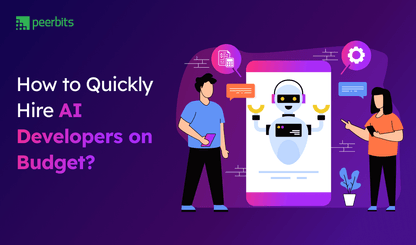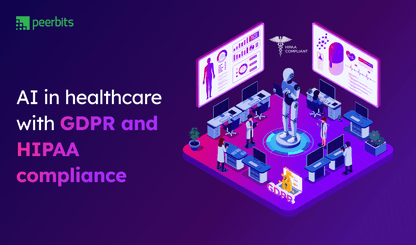You rolled out Generative AI expecting faster response times, improved customer experience, and a noticeable drop in support ticket volume. At first, it looked like things were on track like tickets moved faster, chatbots handled basic queries with ease, and your support team could finally shift focus from fire-fighting to higher-value tasks.
But now? Customer satisfaction scores are mostly flat. The AI makes avoidable mistakes. Accuracy varies between interactions. And your team is starting to question whether they can rely on it at scale.
This kind of friction after adopting gen AI is more common than most teams expect. With the Generative AI market projected to grow from $20.9 billion in 2024 to $136.7 billion by 2030, many companies are moving quickly, often without realizing how much tuning and support GenAI systems really need after launch.
Lets spot the usual gaps early on and handle them with targeted adjustments, the way seasoned teams do, no need to start over. You'll also see where generative AI development services quietly support these adjustments, helping teams get back on track without disrupting live operations.
Let's begin with the challenges in GenAI adoption in detail
#1 Model and data-related challenges
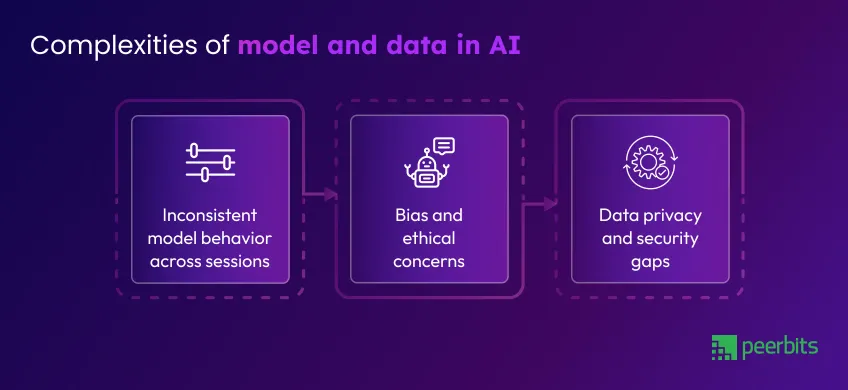
GenAI systems can behave unpredictably when deployed in real-world settings. From inconsistent outputs to ethical risks and privacy concerns, these issues create bottlenecks in both customer trust and internal adoption.
Here are some common problems with Generative AI businesses face post-deployment.
Inconsistent model behavior across sessions
Generative models often produce varied outputs for similar inputs, especially when not fine-tuned with live user data. This inconsistency is a significant challenge of Generative AI adoption.
What it affects:
- Reduces customer trust
- Increases ticket reopen rates
- Teams hesitate to rely on AI-generated outputs
- Affects ROI of Generative AI
Solution:
Introduce feedback loops with real user data, apply consistent prompt tuning, and audit responses regularly to catch and retrain unstable behavior patterns. With the right AI integration services, you can make sure the system remains consistent.
Tools:
- Humanloop: tracks prompt performance and helps iterate them with user feedback
- LangChain: enables session memory for consistency across conversations
- OpenAI evals: tests model behavior across use cases and flags inconsistencies
Bias and ethical concerns
AI models inherit biases from the datasets they’re trained on. These can be subtle (tone, phrasing) or obvious (gender, race, etc.). This poses ethical challenges in Generative AI solution deployment.
What it affects:
- User alienation and backlash
- Legal troubles in regulated sectors
- PR risks in customer-facing use cases
- Part of the wider challenges of AI adoption
Solution:
Use diverse training datasets, apply fairness filters, and routinely test outputs with edge cases. Involve human reviewers for high-stakes queries. A solid AI consulting service can guide businesses through these complex ethical pitfalls.
Tools
- AI Fairness 360 (IBM): audits model bias using pre-built fairness metrics
- What-If Tool (Google): visualizes how inputs affect outputs across data groups
- Fairlearn (Microsoft): helps mitigate and track bias during model development
Data privacy and security gaps
GenAI systems can accidentally surface Personally Identifiable Information (PII) from prior queries or exposed datasets. This brings to light data privacy and security gaps within the system.
What it affects:
- Breach of user trust and legal violations
- Security gaps in multi-user environments
- Barriers to scaling Gen AI adoption safely
Solution:
Mask sensitive data at source, limit prompt memory when not needed, and implement access controls with full audit logs for every GenAI interaction. Adopting a secure Generative AI solution can help mitigate these concerns.
Tools
- PrivateGPT: allows GenAI use on local or offline data without cloud sharing
- Azure AI Content Safety: detects and blocks sensitive content generation
- OpenAI’s data retention controls: lets you disable data logging and memory to protect privacy
#2 Customer experience challenges
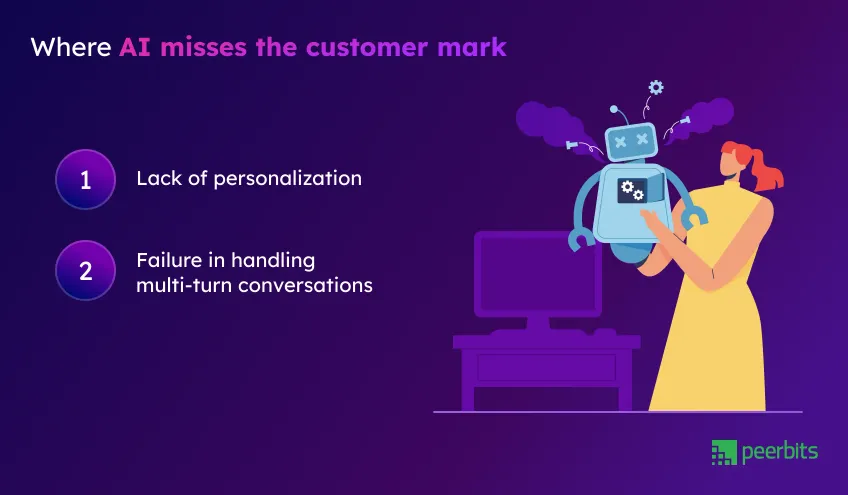
Even with fast response times, poor user experience can hold Gen AI systems back. Most friction happens when the AI fails to feel human enough, adapt to context, or carry conversations the way users expect.
Lack of personalization
When GenAI tools don’t adapt to user history, preferences, or behavior, the conversations feel robotic and generic. This breaks the flow and frustrates users expecting contextual awareness.
What it affects:
- Drops in CSAT and engagement
- Higher user drop-off mid-conversation
- Perception of “just another bot”
- Slows generative AI adoption in Customer experience
Solution:
Use embeddings, memory features, and retrieval-based methods to tailor conversations using user history and context.
Tools:
- Pinecone – vector database that helps retrieve contextually similar past interactions
- LangChain Memory – maintains short-term or long-term memory for personalized responses
- ChromaDB – stores and fetches custom user embeddings for better alignment
Failure in handling multi-turn conversations
Generative AI often struggles to maintain context over longer interactions. This causes the AI to forget earlier inputs or give responses that don’t align with the overall query flow.
What it affects:
- Confusing and broken conversations
- Increased repeat questions and frustration
- Agents getting pulled into escalations again
Solution:
Structure prompts with persistent context, add summarization between turns, and use multi-step planning techniques.
Tools
- ChatGPT with system messages – holds conversation goals and tone across multiple turns
- LangChain Agents – enable task tracking and flow-based conversations
- OpenRouter – supports multi-model orchestration to improve context retention
#3 Internal team-related challenges
Even if the GenAI system works well, internal misalignment can stall progress. Most businesses hit a wall not because of the tech, but because teams don’t have the right collaboration frameworks, expectations, or rollout plans in place.
Lack of clear user adoption strategy
Many teams launch GenAI tools without planning. This leads to low adoption, misuse, or overdependence on fallback support channels.
What it affects:
- Low ROI of Generative AI
- Shadow adoption through unofficial channels
- Resistance from support or CX teams
- Confusion on when to trust the system
Solution:
Define clear usage boundaries, offer onboarding materials for Generative AI teams, and create feedback loops that involve users from day one.
Tools:
- WalkMe / Whatfix – creates guided walkthroughs to onboard users into GenAI-powered workflows
- Tango – generates quick tutorials and SOPs for internal usage
- Hotjar – tracks adoption patterns to find friction in tool usage
Miscommunication between product teams and AI experts
Teams often lack shared language between product managers, engineers, and data scientists. Requirements get lost in translation, leading to mismatched expectations and failed features.
What it affects:
- Delays in feature delivery
- Wasted iteration cycles
- Friction in tuning GenAI for business use
Solution:
Set up shared documentation hubs, use structured requirement templates, and bring AI consulting expert into early roadmap discussions.
Tools:
- Notion / Confluence – Central place for aligned goals, feedback, and versioning
- Productboard – maps user needs into dev priorities, great for cross-functional clarity
- Jira with AI plugins – supports smoother handoffs and issue tracking for Gen AI-related features
#4 Scalability and performance issues
Even if your GenAI use case works fine in a test setup, production-level scaling is a different ballgame. From response latency to infrastructure cost, scaling without planning can eat into margins and user experience fast.
Scaling challenges in real-time performance
When GenAI is expected to handle thousands of real-time user queries or workflows, inference delays and infrastructure bottlenecks show up. Latency, downtime, and model queueing become frequent.
What it affects:
- Slower customer responses
- Higher bounce rates on chat or product interfaces
- Resource strain during traffic spikes
- Drop in customer experience
Solution:
Adopt hybrid deployment (cloud + edge), batch less critical tasks, and explore smaller model variants for quick interactions.
Tools:
- Hugging Face Optimum – helps optimize models for better runtime performance
- NVIDIA Triton Inference Server – streamlines model serving at scale
- AWS SageMaker – autoscaling and load-balancing for inference-heavy workloads
Cost management and budget overruns
Training, tuning, and deploying GenAI can look cheap during POC. But when usage scales, token consumption, compute, and storage costs pile up, often without visibility.
What it affects:
- Monthly cloud bills ballooning
- Unexpected overuse of APIs
- Financial pressure on ROI of Generative AI
- Risk of project getting unprioritized
Solution
Use budget alerts, monitor token usage, and implement tiered access levels for users interacting with the model.
Tools
- PromptLayer – tracks and visualizes prompt usage + API cost trends
- Finout – monitors cloud spend with GenAI usage filters
- LangSmith – offers observability to trim unused or costly prompts
#5 Customer trust and ethical issues
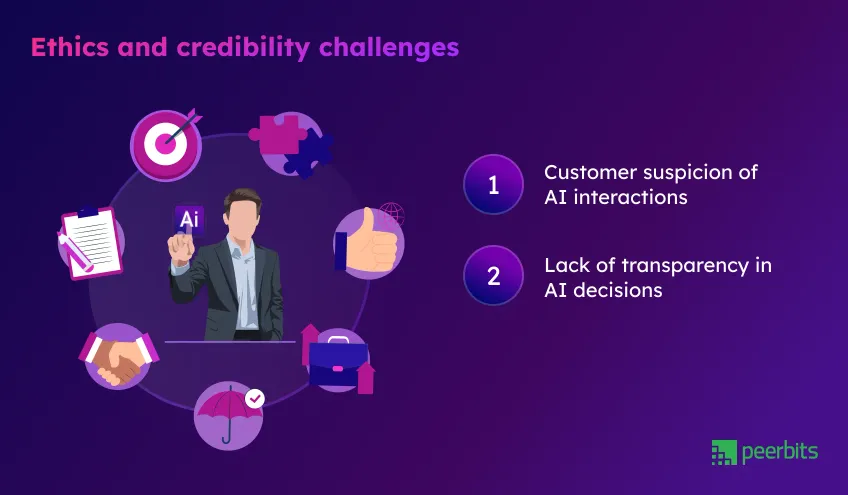
Even when GenAI performs well, users might hesitate to interact with it. Lack of clarity or unexplained behavior often leads to mistrust, affecting overall experience and ROI.
Customer suspicion of AI interactions
Customers often aren’t sure if they’re talking to a bot or a human. If replies feel generic or overly scripted, trust drops, even if the answers are correct.
What it affects:
- Lower customer engagement
- More requests for human support
- Decreased CSAT scores
- Weakened brand image
Solution:
Be transparent about AI usage. Keep the tone natural and give users subtle cues when AI is responding.
Tools:
- LivePerson – shows when AI or human is replying
- Forethought – adds contextual understanding to avoid robotic responses
- Tidio – offers users the choice to talk to a bot or a human up front
Lack of transparency in AI decisions
When AI suggests or acts without showing how it reached a conclusion, both users and internal teams lose trust in the system.
What it affects:
Trust in AI-driven results
Compliance in sensitive industries
Internal adoption and confidence
Audit challenges
Solution:
Use explainable models and simple visuals to show why AI made a decision or where the data came from.
Tools:
- Fiddler AI – tracks how and why the model made a decision
- TruEra – flags bias and explains model behavior
- Zest AI – helps make fair, traceable decisions in finance and risk models

#6 Integration and vendor-related issues
Even if the GenAI model works well on paper, integration hiccups and rigid vendor ties can slow everything down. These often surface after go-live and create friction in scaling or evolving the system.
Vendor lock-in
Relying too heavily on one vendor's stack limits flexibility. It becomes difficult to switch, expand, or bring parts in-house without major effort and cost.
What it affects:
- Limits future customizations
- Slows tech upgrades
- Raises switching costs
- Poses risks if vendor pricing or roadmap changes
Solution
Use open standards and modular setups from the start. Look for vendors that support interoperability and data portability.
Tools
- LangChain – helps abstract models and keep things modular
- Kubernetes + KServe – supports portable model deployment across vendors
- Hugging Face – offers vendor-neutral hosting and model libraries
Integration gaps with third-party platforms
Your GenAI might not play well with CRM, support software, or internal databases. Without clean, bi-directional sync, the system ends up siloed.
What it affects:
- Breaks automation workflows
- Delays response time
- Increases manual workload
- Reduces overall efficiency
Solution:
Choose tools with native connectors or use middleware like iPaaS platforms to bridge integration gaps early on.
Tools:
- Zapier – automates triggers between systems without code
- Workato – connects enterprise-grade platforms with complex flows
- Tray.io – enables flexible integrations for support and marketing stacks
#7 Regulatory and compliance issues
Regulatory pressures and compliance standards can quickly become a headache once GenAI is deployed. Businesses need to ensure that their diverse AI models meet legal standards, or risk fines, legal action, or damage to reputation.
Failing to meet compliance standards
AI models need to align with data protection laws like GDPR, CCPA, and HIPAA. If they don't follow these regulations, businesses can face severe legal and financial consequences.
What it affects:
- Legal liabilities
- Customer trust
- Brand reputation
- Heavy fines and penalties
Solution:
Incorporate compliance checks and audits in the early stages. Work with legal and compliance teams to ensure GenAI models adhere to all required standards.
Tools:
- OneTrust – helps with managing privacy and compliance requirements
- BigID – automates data discovery and helps ensure compliance with regulations
- Privitar – enables privacy-preserving AI and ensures compliance across models
5 Warning signs your GenAI needs optimization
Initial deployment doesn’t guarantee long-term impact. Spotting the signs early can prevent operational drift and user dissatisfaction.
1. Accuracy issues or hallucinations becoming normal
- Frequent inaccurate or irrelevant responses
- Reduces customer trust and satisfaction
2. Customer satisfaction not improving
- No noticeable improvements in CX metrics
- Potential misalignment with customer needs
3. Support team avoids using the system
- Team feels the system is unreliable or inefficient
- Impact on productivity and issue resolution
4. Latency, cost, or observability issues
- High latency or unanticipated costs
- Difficulty in tracking performance and system bottlenecks
5. No alignment across leadership, product, and ops
- Lack of unified goals and communication
- Leads to mismanagement and unmet expectations
Key characteristics of stable Generative AI operations
- Hybrid workflows: Blend automated responses with human support in critical or high-stakes scenarios to maintain accuracy and trust.
- Guardrails, scoring, and fallback logic: Set predefined boundaries and scoring systems to catch bad outputs and redirect to safer or more reliable paths when needed.
- Business-data grounding via RAG or external APIs: Anchor AI responses in your company’s internal knowledge or systems using - Retrieval-Augmented Generation or real-time APIs.
- Model observability dashboards (like Langfuse, Helicone): Track performance, latency, and user interactions with purpose-built tools that help you debug and improve outputs.
- Internal rollout + feedback tooling: Let your team test new features internally and provide feedback directly from the UI before going live.
- Cost and latency optimization: Fine-tune prompts, cache repeat queries, and route requests smartly to control cloud bills and reduce delays.
- Modular architecture to avoid vendor lock-in: Build flexible systems with interchangeable parts so you’re not stuck with one model, provider, or tool.
Conclusion
Most Generative AI underperformance issues stem from delivery and integration challenges, not flawed models. Common problems like integration gaps and inconsistent feedback loops can be fixed without requiring a full rebuild.
Experienced teams use hybrid workflows combining AI and human input. They ground models with external APIs and leverage tools like observability dashboards to enhance accuracy and customer experience.
If your Generative AI setup is underperforming, it's usually fixable with smart adjustments. Whether it's optimizing costs, improving latency, or enhancing feedback loops, small fixes can make a big difference. By tackling these issues, you can unlock the true potential of your Generative AI without starting from scratch.



